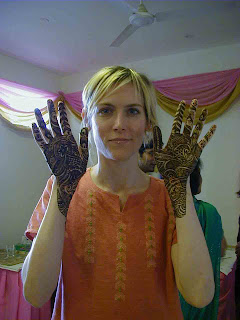

well, one of the boys from the kitchen just woke me up early to make sure I gave him and the others their tip money while his boss was sleeping - seems the tips don't go to to them if the boss is awake . . .the money thing is really difficult to deal with in India, it is so much more direct and the numbers all seem like nonsense when you try to go back and forth between the currencies and headspaces . . ..
Orcha was a beautiful city filled with temples just plonked down in the middle of the people, shops, cows, goats, and dogs. Almost everyone, children in particular, say hello or namaste; some ask for school pen or chocolate but when we say no they smile and ask where from. At dusk we get beset by a group of children pleading to have their photo taken; after several attempts they drag us to a small dirt patch and demonstrate their cricket skills. One does a cartwheel and asks me to do the same - I would comply, give them something to laugh about but I can't figure out how to do it without my skirt ending up around my neck. The ringleader, the cartwheel girl, who is a real firecracker, starts to dance with me. When I dance, she drags me over to a nearby doorway and pulls me into a living room with a surprised mother and two other children; they flip around the channels to find a good music video and then she and I dance various styles of different eras and cultures . . .she is particularly good at swing, and she dances with Patty when I get tired and then Jill, and then with one of the other girls. Others poke their heads in and laugh at us; there is much laughing and dancing and photo-taking and we finally extricate ourselves into the quiet black night.
We sit on the patio of our hotel in cast iron chairs that weigh several tons and drink beer and then watch the man making bread in the tandoor below. He sees us watching and starts to throw the dough in the air like a pizza, laughing; one falls to the ground and he stops making eye contact, I guess deciding he’d better focus on the task at hand.
In Khajuraho Schrat and I have reached a point of familiarity that we spend several minutes before getting into our adjacent beds chasing and killing mosquitoes and flies in our underwear. The banging and oaths and laughter must drift directly through the thin walls and the other guests must be wondering what’s going on; maybe they are performing the same ritual. WE sleep well, that night, no buzzing or bites.
The fort at Orcha is imposing and beautiful; I look for a place to throw away the packaging from my batteries and a man at the gate offers to do it for me; he takes the cardboard and plastic from me and drops it over the stairs into a pile of detritus on the ground below. Gill has read in her guidebook the suggestion to travelers that they bury their rubbish to prevent the animals from finding and eating it – the writers seem not to be aware that the animals actually survive on the rubbish and we’re actually helping them by leaving it easily accessible.
We refuse the offers for a guide but then once inside the fort one offers to show us the rooms that were the King’s and his wives’; he unlocks them and the insides are painted with fantastic murals of Krishna and Hanuman and elephants and beautiful women; the colors still vibrant and stunning. Sometimes the guides really can show you things you wouldn’t see without them. One offers to take me underground where the king’s soldiers were housed; he shows me the toilet, the central, low room where water collected, and one room with a hole where sunlight streamed through.
We drive to Khajuraho; I see a man making a basket, standing inside it as he works to use his feet as anchors; later I see a cow, eating a basket in basically the same posture. Everything is circular here.





































